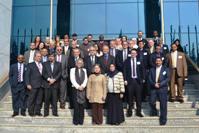 A two-day consultative meeting to determine the public health research agenda for Middle East Respiratory Syndrome Coronavirus (MERS-CoV) took place in the WHO Regional Office for the Eastern Mediterranean in Cairo from 15 to 16 December 2013.
A two-day consultative meeting to determine the public health research agenda for Middle East Respiratory Syndrome Coronavirus (MERS-CoV) took place in the WHO Regional Office for the Eastern Mediterranean in Cairo from 15 to 16 December 2013.
The meeting was attended by representatives from the Ministry of Health and Ministry of Agriculture of the affected countries in the WHO Eastern Mediterranean Region (Bahrain, Saudi Arabia, Kuwait, Oman, Qatar and Tunisia), the Food and Agriculture Organization of the United Nations (FAO), World Organisation for Animal Health (OIE), the WHO Collaborating Centre for Virus Reference and Research (Special Pathogens), US NAMRU-3 and WHO.
Since the emergence of MERS-Cov, the collaborative work of public health authorities all over the world, in particular in the affected countries in the Region, WHO and other international health agencies has resulted in a steady increase in knowledge on the evolution of this novel virus. Nonetheless, a lot still remains to be learned about the origin of this virus, its possible animal reservoir, transmission kinetics, and other aspects of its ecology.
Recently, the virus has been detected in camels that were linked to confirmed human infections in Qatar and Saudi Arabia. Although, the detection of this virus in camels provides further insight into the possible animal reservoir, the primary source of MERS-CoV infections remains unclear and the link to humans, particularly what type of behaviour or exposure result in human infections needs to be elucidated further as exposure to animals has only been documented for a limited number of human infections with MERS-CoV until now. It is with this in mind that this consultative meeting has been convened by WHO to address some of the critical knowledge gaps that WHO and other international scientific communities are currently grappling with on exposure risk, transmission chain and the extent of spread of the virus.
It is expected that this consultative meeting involving the affected countries in the Region, FAO, OIE and WHO will elaborate at length over the next two days to discuss and agree on a timeline for conducting further epidemiological studies (like case-control and sero-epidemiological studies) to determine risk factors and types of exposure that may be associated with infection in humans, and to better understand the extent and geographic distribution of infection in humans caused by this novel virus. The meeting is also expected to determine key animal studies that can help in identifying possible animal reservoirs of the virus.
Dr Ala Alwan, WHO Regional Director for WHO Eastern Mediterranean inaugurated the meeting and said that he hoped that the scientific and the public health communities across the globe would combine their efforts to respond to this emerging public health threats of the present time. In his words, “No one organization can handle such threats alone. The situation calls for a collective response. Protecting health security from the threats of MERS-CoV to global health is a shared responsibility and everyone should rise to the occasion”.








